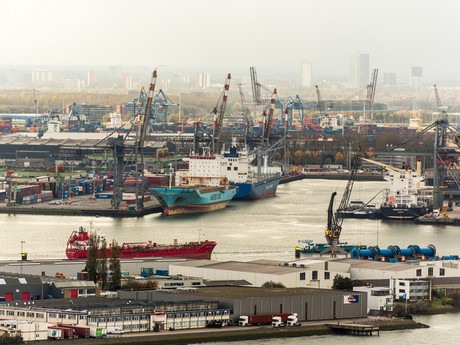In total, 8 million tonnes of fresh fruit and vegetables arrive in the Netherlands every year, and 11 million tonnes depart the country. Of the fresh fruit and vegetables arriving in the Netherlands, not even 20 per cent is meant for the domestic market. The remaining 80 per cent is transported to other countries. Of the departing stream, about 40 per cent has been grown in the Netherlands, and 60 per cent concerns foreign product. The fresh fruit and vegetables transported to other countries through the Netherlands amounts to about 7 million tonnes. This is more than the roughly 4 million tonnes of Dutch product sold abroad.

Regular import/export, re-export, semi transit and actual transit
Besides the import of fresh fruit and vegetables for the Dutch market and the export of fresh produce grown in the Netherlands, there’s a large flow arriving in the country to be transported further abroad. That flow can be divided into three parts. Firstly, the so-called re-export. These are products that are cleared in the Netherlands and (temporarily) become owned by a Dutch company before being re-exported again. This flow amounts to about 3.7 million tonnes.
Secondly, a large flow of product is sent on via the Netherlands but remains the property of a foreign company. Administrative acts are taken for part of this, but Customs don’t enter into the matter for the remaining (larger) part. The flow for which Customs formalities are conducted is called semi transit, and amounts to about 0.9 million tonnes.
Finally, the remaining flow is actual transit transport. In transit, both semi and actual, Dutch transport companies can be involved, but the product remains the property of a foreign company.
Figures regarding actual transit aren’t systematically collected, but according to Statistics Netherlands it concerns substantial amounts. Statistics Netherlands made an estimate for the agricultural products, and the ratio of semi and actual transit is 1:4. The semi transit is practically nil for fresh vegetables, and it’s 0.9 million tonnes for fresh fruit. With careful estimates the actual transit for fresh fruit would amount to 2.0 million tonnes.
Fruit export: less than 10 per cent Dutch product
There’s a big difference in the trade flow between fresh fruit and fresh vegetables. In fresh vegetables, the importance of foreign product is much smaller than in fresh fruit. Of the total departing flow of fresh vegetables, 80 per cent is Dutch product. In fresh fruit it’s not even 10 per cent. Of the total incoming trade flow of fresh fruit and vegetables, not even 20 per cent remains on the domestic market. The difference between fruit and vegetables isn’t as significant in this case. Of all of the incoming fresh fruit, about 15 per cent is meant for the Dutch market. It’s slightly more for fresh vegetables, about a quarter. On the Dutch market for fresh vegetables, Dutch product is dominant with a share of more than 90 per cent. In fresh fruit that’s about 30 per cent.
Difference between Statistics Netherlands and Eurostat
The figures of the Dutch import and export of fresh vegetables have been compiled by Statistics Netherlands, which passes these figures on to Eurostat. Since 2016, the Eurostat figures for the international trade of the Netherlands include the (estimated) import and export by smaller companies. Besides, the Eurostat figures include semi transit, while Statistics Netherlands excludes this trade flow. Semi transit does play a part in the statistics for international trade, but isn’t part of the national account.
More fresh fruit and vegetables imported and exported this year
Eurostat figures show that both the import and the export of fresh vegetables have once again increased this year. In the January-August period, import grew by 10 per cent and export by 7 per cent. Over the entire year, the export of fresh fruit and vegetables is estimated to amount to more than 9 million tonnes in 2018. The smaller exports of important products such as onions and carrots in the final months of the year has been included in this figure. The harvests of these products were smaller compared to last year due to the dry weather (onions: -44%). Up till August, the onion export was 7 per cent larger than last year, and the carrot export was even 35 per cent larger.
A remarkable grower in Dutch export is banana. This product is now the third export product, after onions and tomatoes.
Importance of EU even bigger
In 2018, the importance of EU countries was bigger than last year in the Dutch export. Up till August, the share of EU countries was nearly 90 per cent in total. With a share of more than 30 per cent, Germany is by far the most important buyer.
Banana biggest product
Of the Dutch import of fresh fruit and vegetables (including semi transit), banana is by far the most important product of the Netherlands. Throughout 2018, more than one million tonnes will have been imported. Of this, about three-quarters is re-exported. With an estimated 600,000 tonnes throughout 2018, oranges are the second import product. This is slightly more than in 2017. This is followed by grapes (+3%), pineapple (+16%), avocado (+26%), grapefruit (+8%), apples (+27%), melons(-2%), tomatoes (+7%), onions (+15%), mangoes (+5%) and tangerines (+16%).
More from South Africa
Spain is by far the most important supplier, although they didn’t grow last year. Fewer oranges arrived from Spain, but more tomatoes and tangerines were imported from this country. South Africa is the second supplier. Import from this country was 10 per cent larger than last year. Less was imported of the most important product, oranges, but more grapes, grapefruit, lemons and avocados were imported.
For more information:
Jan Kees Boon
Fruit and Vegetable Facts
www.fruitandvegetablefacts.com
[email protected]
